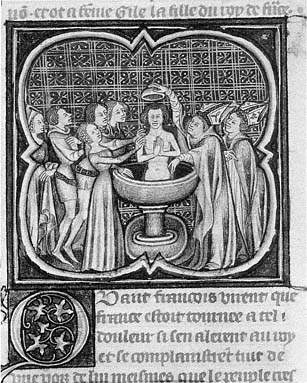Saintly Ancestors as Models of Kingship
Charles V's political motives also explain the dense cycles of the lives of Charlemagne and Saint Louis, particularly since no visual models have been found for them. Charlemagne's importance for French kingship and his special significance to Charles V must have been a factor in the elaboration of this sequence of illustrations.[10] Charles had a chambre de Charlemagne in his Hôtel Saint-Pol and was often compared to Charlemagne in the prefaces of works that he commissioned, such as Raoul de Praelles's translation of the City of God in 1375.[11] Charles V was the first French king actively to promote the cult of Charlemagne. In a speech delivered in 1378 Charles even referred to "saint charlemaine," a status that Charlemagne was not usually accorded.[12]
As Charles V's only canonized ancestor, Saint Louis also earned a special place in the Grandes Chroniques . Devotion to Louis was widespread, particularly among his Capetian descendants, who commissioned numerous cycles of his life. Charles V's densely illustrated version of Saint Louis's life continues this Capetian tradition but may also assert the legitimacy of the new Valois line, as in John the Good's Grandes Chroniques .

Figure 70
The baptism of Rollo. Grandes Chroniques de
France . Bibliothèque Nationale, Ms. fr. 2813, fol.
166v. Photograph: Bibliothèque Nationale, Paris.